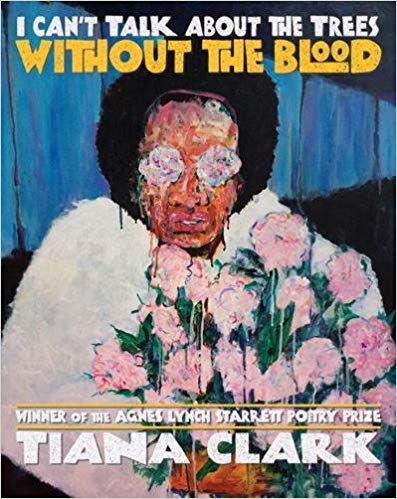
(University of Pittsburgh Press, 2018)
REVIEW BY CORI BRATBY-RUDD
—
Tiana Clark’s second poetry collection, I Can’t Talk About the Trees Without the Blood, delves into Clark’s racialized experiences as a Black woman living in the South. The entire collection functions as a complex personal re-telling of the way such histories of violence can live on in the bodies of those who occupy land and live near spaces–like the trees of the book’s title–that were once the site of mass pain and violence.
With cover art by esteemed poet and artist, Terrance Hayes the work is visually compelling and complex even before opening to the first page. The impressionistic painting of a Black woman holding a bouquet, with two of the pink flowers covering the woman’s eyes, readers are immediately introduced to a world of the unseen, complex, and deep beauty.
Perhaps one of the strengths of the collection, besides the compelling, haunting and unique prose, is the careful organization with which Clark organized the entire text. For instance, the book itself is split into three sections. After being introduced to the first section title called, “I Can’t Talk”—and by quickly skimming through the next sections, it becomes clear the entire book title, I Can’t Talk About the Trees Without the Blood is actually broken down small section titles within the book itself. As such, each of the three collection sections are titled: I Can’t Talk / About the Trees / Without the Blood.
Another of Clark’s assets’ is her profound mastery of poetic form. From the first poem in the section “I Can’t Talk,” titled “Cross/Bite” which appears in the poetic form of a Curse, to concrete poems, to her frequent use of couplets, Clark simultaneously deconstructs issues of race, class and gender in the South while expertly writing in forms that feel natural and unforced.
Following the theme of talented title creations: “Cottonmouth” appears after the curse poem “Cross/Bite.” Reflecting on the history of cotton, specifically the history of cotton picking, and the use of slaves to pick the cotton, the title uses wordplay to not only imply the same silence, but to racialize that silence. By the end of this poem, a small section even appears shaped as an empty open mouth. Themes of mouths and silences appear through the entire section, as readers become both uncomfortable in the brute reality of racism, and also awed with Clark’s ability to break down seemingly mundane micro aggressions—like a family member asking to take a family photo at a former plantation- i.e. a mass grave for slaves.
By bringing a voice to a history and a pain that is largely under-discussed, Clark’s work of documenting her story in a quasi-memoir collection uses sharp language that is both haunting and rhythmically enchanting. Clark has confirmed that many of the pieces reflect stories from her personal life, and told reporters that “Whenever I look at a tree in the South, I’m always going to see the blood on that tree. I’m always going to see the strange-fruit history that exists within that tree.”
Themes of mouths, silence and blood echo through the entire collection, painting vivid pictures of a country still seeped in racism and sexism. Each poem demands attention, and each poem stands on its own—but when placed together, they build off one another. Like the silence and mouth imagery echoed in the first section, “Without the Blood” also uses images of blood and wounds throughout. That being said, despite the violence implied by the title and the images, the work itself is not, as Clark puts it herself, “slavery porn.” Rather, each moment of blood or bones are seemingly from day-to-day stumbles with violence that subtly echoes throughout. Through the hanging clothes lines, over the drying sheet we see a place where Uncle Vernon hid from the KKK. The section is thus literally “Without the Blood” as readers see the extensions and lives experiences of violence, but not the acts themselves. The actual depictions of violence, sexual assault, and lynching are mostly in the “I Can’t Talk” section.
After the section ends, readers are greeted by a poem that proceeds the epilogue, titled “How to Find the Center of a Circle,” in which Clark ends her book with a haunting image of little white boys circling around her. The boys, on skates, taunt Clark, forming a circle of hatred that she can neither physically nor emotionally escape from. The top of the poem actually hold the formula for creating a circle—thus planting the reader with Clark at the center of her circle of pain that is made of iron. The circle encompasses Clark’s intention with splitting her section titles, readers thus circle and fall back from any progress Clark’s prose may have led us through. We are surrounded by trauma and cannot escape it. As soon as one part of the circle is complete, we dive back into it. Thus, we arrive at the end only to know that we are meant to endlessly circle around these topics, encased in the extremely tangible and the subtle racist and sexist micro-aggressions that have carved Clark’s life.
—
Cori Bratby-Rudd is a queer LA-based writer. She graduated Cum Laude from UCLA’s Gender Studies department, and is a current MFA Candidate in Creative Writing at California Institute of the Arts. Cori enjoys incorporating themes of emotional healing and social justice into her works. She has been published in Ms. Magazine, The Gordian Review, Califragile, among others. She recently won the Editorial Choice Award for her research paper in Audeamus Academic Journal and was nominated as one of Lambda Literary’s 2018 Emerging Writers.
![[PANK]](https://pankmagazine.com/wp-content/themes/pank/assets/images/pank-logo-large.png)
